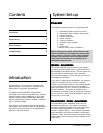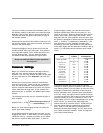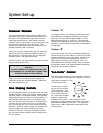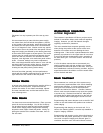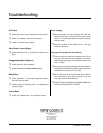
Page 6
STATEMENT Set-up Manual
Room Acoustics
Your RoomYour Room
Your RoomYour Room
Your Room
This is one of those areas that requires a
little background to understand and some
time and experimentation to obtain the best
performance from your system.
Your room is actually a component and an
important part of your system. This compo-
nent is a very large variable and can
dramatically add to, or subtract from, a great
musical experience, depending on how well
you attend to it.
All sound is composed of waves. Each note
has its own wave size, with the lower bass
notes literally encompassing from 10' to as
much as 40'! Your room participates in this
wave experience like a 3 dimensional pool
with waves reflecting and becoming
enhanced depending on the size of the
room and the types of surfaces in the room.
Remember, your audio system can literally
generate all of the information required to
recreate a musical event in time, space,
and tonal balance. The purpose of your
room, ideally, is to not contribute to that
information. However, every room does
contribute to the sound and the better
speaker manufacturers have designed their
systems to accommodate this phenomenon.
Let’s talk about a few important terms before we begin.
Terminology
Terminology
Standing Waves. The parallel walls in your room will reinforce certain
notes to the point that they will sound louder than the rest of the
audio spectrum and cause “one note bass”, “boomy bass”, or
“tubby bass”. For instance, 100Hz represents a 10' wavelength.
Your room will reinforce that specific frequency if one of the
dominant dimensions is 10'. Large objects in the room such as
cabinetry or furniture can help to minimize this potential problem.
Some serious “audiophiles” will literally build a special room with
no parallel walls just to get away from this phenomenon.
Reflective Surfaces. The hard surfaces of your room, particularly if
close to your speaker system, will reflect those waves back into
the room over and over again, confusing the clarity and imaging of
your system. The smaller sound waves are mostly affected here
and occur in the mid and high frequencies. This is where voice
and frequencies as high as the cymbals can occur.
Near Field Reflections. Those reflective surfaces of the room that are
the closest to your speaker system, particularly if they are hard
surfaces, can reflect the musical energy back into the room,
confusing the imaging and tonal balance of your system. Exces-
sive brightness can result from this condition and diffuse, ill
defined imaging can easily occur if too many surfaces near your
speakers are hard and sharp in their relative angle to your system.
Resonant Surfaces and Objects. All of the surfaces and objects in
your room are subject to the frequencies generated by your
system. Much like an instrument, they will vibrate and “carry on” in
syncopation with the music and contribute in a negative way to the
music. Ringing, boominess, and even brightness can occur
simply because they are “singing along” with your music.
Resonant Cavities. Small alcoves or closet type areas in your room
can be chambers that create their own “standing waves” and can
drum their own “one note” sounds.
Clap your hands. Can you hear an instant echo respond back ?
You have near-field reflections. Stomp your foot on the floor. Can
you hear a “boom”? You have standing waves or large panel
resonances such as a poorly supported wall. Put your head in a
small cavity area and talk loudly. Can you hear a booming? You
have just experienced a cavity resonance.




